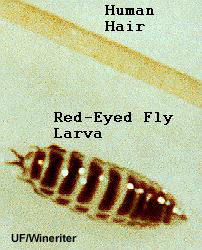Biological Control of Mole Crickets By Ormia depleta (Brazilian Red-eyed Fly)
|
|
Ormia depleta (Wiedemann) (OR-mee-a dep-LATE-a) is a species of tachinid fly (tach-INN-id) native to South America. In the 1930s in Amazonian Brazil, its larvae were found to be parasitoids of Neoscapteriscus mole crickets. An unsuccessful attempt was then made to introduce the fly into Puerto Rico as a biological control agent for the West Indian mole cricket. In the 1980s in Paraguay, adult female Ormia depleta were found to be attracted to songs of tawny and southern mole crickets when these songs were produced artificially by a sound emitter developed by the UF/IFAS mole cricket program. This gave a method of trapping the female flies, and was used by the UF/IFAS mole cricket program in southern Brazil in 1984–1989. It was found that larvae could be dissected out of the gravid flies that were trapped, then placed on mole crickets, and would burrow into and parasitize the mole crickets. These larvae developed in about a week, killing the mole crickets in the process. The larvae pupated in soil, and adult flies emerged from the pupae about 11 days later. Survival of the newly emerged adult flies was very poor in cages, and repeated attempts failed to get the flies to breed in a laboratory in Brazil.
In 1987, thanks to studies made on Ormia ochracea at the University of Florida, methods finally were devised for getting Ormia depleta to breed in captivity. Following that success, flies were released near Gainesville in April 1988 and at Bradenton in October 1988; they established populations at both places. Ormia depleta was dubbed the “Brazilian red-eyed fly” by the popular press. From 1989–1992, releases were made in several other counties, many of them on golf courses under a project sponsored by the Florida Turfgrass Association. By December 1994, there seemed to be a continuous population of flies in at least 37 counties, from Alachua to Dade. There was no information about establishment in counties north of Alachua, nor was there information about the proportion of mole crickets killed by the fly.
Ormia depleta is believed to be a specific natural enemy of Neoscapteriscus mole crickets because the gravid females need to hear the song of Neoscapteriscus borellii (Giglio-Tos) or Neoscapteriscus vicinus (Scudder) in order to find and lay their larvae on those hosts. The female flies also lay larvae on other mole crickets very close to the singing mole crickets. Native species of Ormia in the southern United States have never been found to attack Neoscapteriscus mole crickets for similar reasons: they require to hear the song of Gryllus or Neoconocephalus to find these hosts. Therefore Ormia depleta is safe to nontarget organisms. The adult flies neither bite or sting people, and because they are active at night when mole crickets sing, they are unlikely to be seen by people.
 |
The optimal use of Ormia depleta is as a classical biological control agent. It is labor intensive and thus expensive to rear in the laboratory, and the chances of reducing the labor costs are slight. However, when released in the field in central and southern Florida it has shown the capability of establishing permanent populations. These established populations will kill mole crickets, and they do so at no recurrent cost. Therefore, in places where this fly has established populations there is no point in releasing more.
 |
It may be that there will be a northern limit to the area the fly can occupy permanently because of cold winter temperatures farther north destroying honeydew sources on which adult flies depend for their survival. If this should be the case, then it may prove worthwhile to release flies in the northern area when the weather warms up each spring to the point where honeydew is available. Flies to be moved north and released could be: (1) flies caught in traps in the south and shipped north for release, or (2) flies reared in laboratories. These possibilities might allow for commercialization of the fly in northern areas.
|
Biological control of mole crickets by Ormia depleta is an extremely low-energy form of pest control, since only the research phase requires energy input. This is true in general of classical biological control. An assumption is made here that releases of the fly, to get populations established, were part of the research phase. That assumption is valid for releases made in 1988–1993 in Florida because the outcome of none of the releases could be predicted: all were experimental.